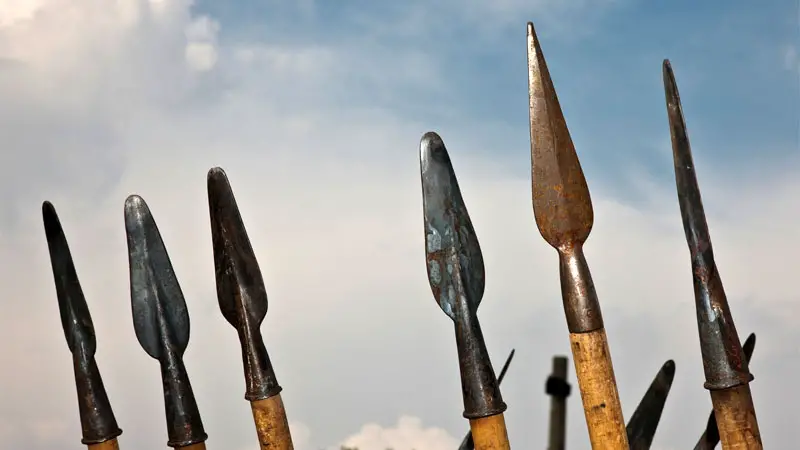From the earliest days of Mankind, spears have been an essential tool for hunting, defense, and warfare. While the simplest spear is just a pointy stick, early Man soon discovered they could add tips made of bone or stone to make the spears more lethal.
Since then, spears have enjoyed a huge degree of innovation and use by almost every culture, with some very unusual variations springing up. Some spears are designed to be thrown, some wielded in melee, and some can perform both functions.
Here are just some of the many types of spears out there.
Related: 13 Different Kinds of Crossbows
Types of Spears
1. Brandistock
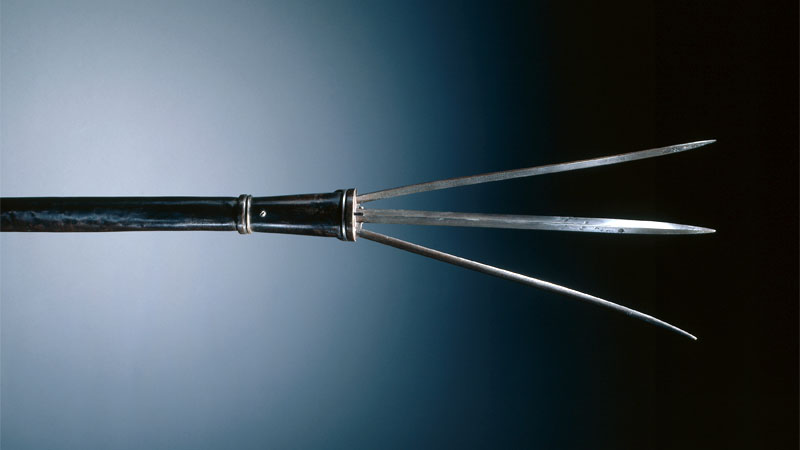
This Italian spear was used extensively between the 1500s to 1800s by the military, civilians, and even police. It was about five feet long and featured a retractable head. The head consisted of one to three spikes which were stored inside a hollow in the end of the shaft.
When thrust, the spikes would come out and could be locked into place. This feature made the brandistock rather unique among spears.
2. Dory

The dory was the primary weapon of Greek hoplites and generally measured between six and nine feet long. The shaft was usually made of cornel or ash, while the leaf-shaped head and end spike were made from iron.
The spike had multiple functions, such as anchoring the spear, serving as a substitute head if the dory broke, acting as a counterbalance, and even being used to kill fallen enemies as the hoplites marched over their bodies.
3. Glaive

One of the more iconic spears from the Late Middle Ages, the glaive is a spear with a long, curved blade at the end. The blade is most commonly 18 inches long, with a socket at the end instead of a tang.
The shaft tends to be around six or seven feet long. Because the name of this spear also refers to short swords in French, it’s hard to pin down just how old this type of weapon is or where in Europe it originated.
4. Glaive-Guisarme

This is a variant of the glaive in which the blade has a small hook on the back of the blade. The hook was used in the same fashion as a guisarme, making it easier to yank mounted soldiers from their horses.
See Also: 21 Types of Horse Saddles
5. Hoko Yari

This Japanese spear is believed to have been inspired by a Chinese design and likely first appeared in the 700s AD. They are said to have had a wavy-edged or leaf-shaped blade a little over 7 ¾” inches long mounted on a six-foot pole.
Instead of a tang, the blade had a hollow socket for the end of the shaft. Some versions had horns similar to those on a ranseur.
6. Ji

This Chinese spear remained popular for over 3,000 years. There are numerous variations of head for this weapon, although all contain one to two side blades of some sort. This could be a small axe head but were more commonly a straight or curved dagger blade.
When two side blades were present, the second was usually a hook but could also be an axe or dagger blade. Today, the ji is still used in several Chinese martial arts disciplines.
See Also: 17 Different Types of Barbed Wire
7. Naginata

Fans of martial arts or anime will be quite familiar with this Japanese spear. These beautiful weapons had slightly different variants for men and women and are believed to be a descendant of the hoko yari.
The naginata has a long, curved, single-edged blade with a long tang that’s inserted into the shaft and held in place by a wooden peg called a mekugi. In many cases, a tsuba (or rounded handguard) is located between the blade and shaft.
To protect the weaker area where the tang is inserted into the shaft, this area, called a tachiuchi is reinforced by metal rings or sleeves, then wrapped in cord. The other end of the shaft is protected by a heavy metal cap.
This weapon has its own form of martial art, known as naginatajitsu. Practitioners tend to use one of two wooden versions for sparring, rather than live steel. It’s generally believed the weapon was developed at some point in the Heian Period (794-1185 AD), as the first clear reference was made in 1146.
When not in use, naginata are protected with a wooden sheath.
8. Partisan
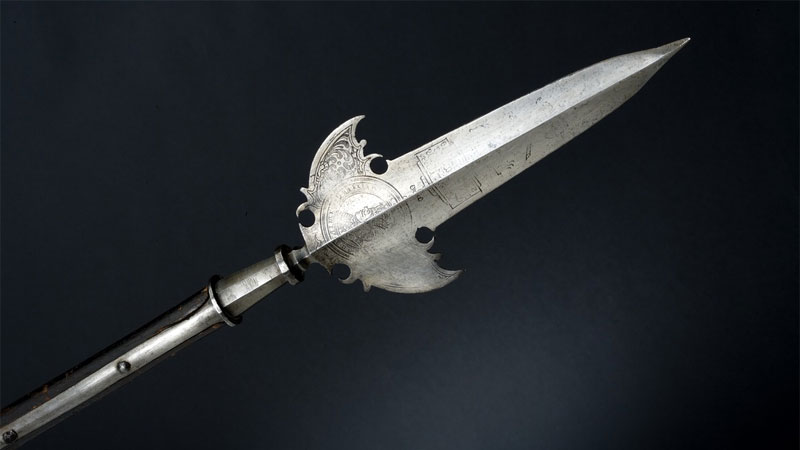
In use from the 1400s to 1600s, the partisan was a spear wielded primarily by infantrymen. The pearhead had two protrusions, one to either side, that served as sword catchers and aided in parrying.
As with most military spears, the partisan became obsolete with the advent of the musket. However, it’s still used to this day in ceremonial roles.
9. Pike

The term pike actually refers to a long, two-handed spear and not one specific spear design. As a result, they can vary in length from 10 to 20 feet long. The head is usually a traditional spear tip, although other types of head can also be found.
However, weapons categorized as pikes didn’t include bladed tips. The area near the spearhead was reinforced with metal strips and tapered slightly, with the shaft often being made of ash to give it more durability.
Pikes were eventually supplanted by the bayonet, but were still in use in major conflicts throughout the world until quite recently. They were present during the French Revolution and American Revolution.
The British War Office had ordered pikes to be made available to the Home Guard in 1942, but the defenders refused to use them. Pikes were also used as a boarding weapon in naval warfare until the late 1800s. Today, their use is purely ceremonial.
10. Ranseur

This possible descendant of the septum is a rather unique weapon that saw military use into the 1400s and continued to be used as a ceremonial weapon as late as the 1600s. Sometimes referred to as a roncone, the blade was mounted on a shaft of six feet or more.
The spear tip had two protrusions to the sides that were either curved or angled forward. These served as sword catchers and could also be used for parrying. While not common, some variations had sharpened edges. The design not only worked well for defense, but could also be used to pull soldiers off of their mounts.
11. Sarissa

This early pike was commissioned by Philip II to replace the shorter dory. This Macedonian spear measured 13 to 20 feet long and were made of cornel wood. These heavy spears weighed 12 to 14 pounds and featured an iron leaf-shaped head.
The other end had a bronze spike that could be used to anchor the spear into the ground so the enemy charge wouldn’t easily shift it. It also served as a counterbalance and could be used as the main spear tip if the iron end broke during combat.
The long length gave Macedonia’s phalanxes a distinct advantage on the battlefield, as they could anchor the sarissas and layer them, forming an almost impenetrable wall. However, the sheer length meant that it was unwieldy during marches, so the haft often consisted of two pieces that connected with a bronze tube, allowing the weapon to be tied to the soldier’s back when not in use.
The weapon slowly fell out of favor when Alexander the Great began to phase out phalanxes in favor of Asian troop types and weapons.
12. Spetum
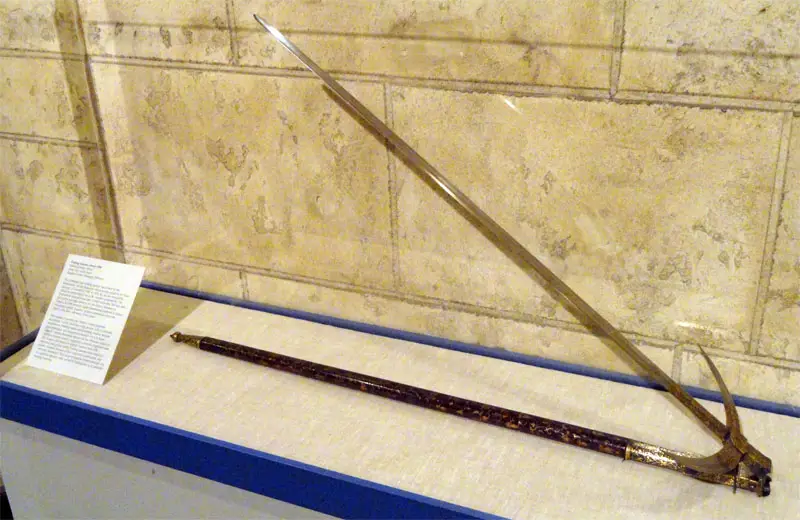
This spear saw plenty of use during the Crusades and inspired later designs such as the ronseur. It consisted of a 12 to 14 inch blade attached to a six to eight foot shaft.
The main blade has two single-edged side blades that could be used for slashing or parrying, while their blunt backs were useful for knocking shields and people away.
13. Spontoon
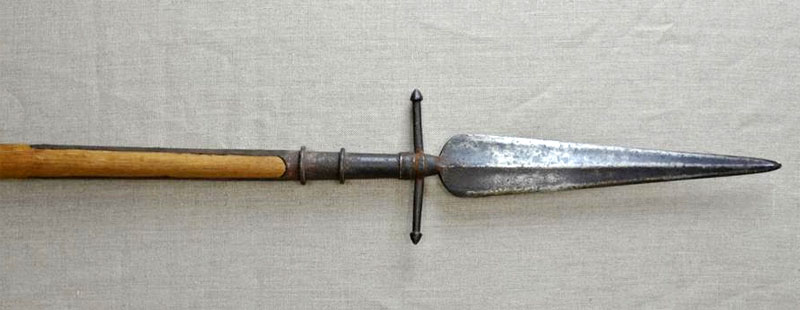
Better known as the half-pike, this spear was in common use during the 1600s but by the 1800s had become largely ceremonial. Unlike a full pike, these spears only measure around six to seven feet long.
It’s widely believed that the spontoon originated in Italy, although the advent of the musket eventually supplanted it as a weapon. However, it continued to be used by generals to signal their troops and was even used by American generals after the Revolutionary War.
14. Tepoztōpīlli

This spear was a popular weapon of the Mēxihcah and could range from three to seven feet in length. It had a wedge-shaped head that was edged with obsidian blades that fit into deep grooves on the head and affixed using either plant resin or bitumen.
Because of their design, they could be used as both a piercing and slashing weapon.
15. Trident
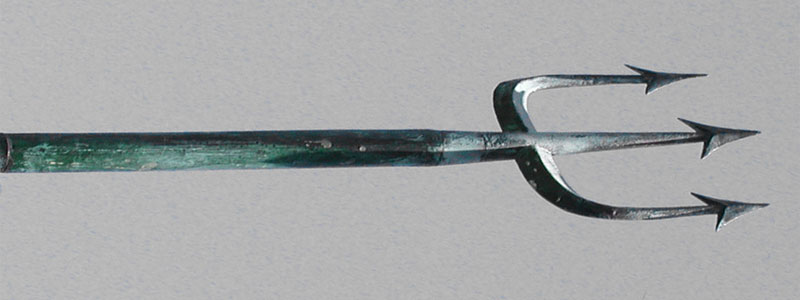
Originally a type of fishing spear, the trident became linked with Poseidon and triton in classical mythology. When the Indo-Europeans invaded the Indian Subcontinent, they adapted their religion into what is now Hinduism, and became a symbol of Shiva.
The name itself means “three teeth”, while its Sandskrit name, trishula, means “three thorns”. Frequently used in warfare and gladiatorial combat, the trident remains one of the most distinctive spears to this day.

